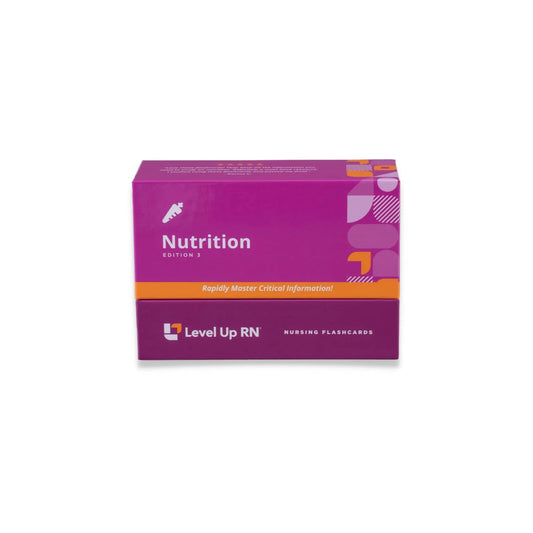Hi, I'm Cathy with Level Up RN. In this video, I will be discussing nutritional guidance for a number of renal disorders, including acute kidney injury, chronic kidney disease, nephrotic syndrome, glomerulonephritis, and urolithiasis. At the end of the video, I'm going to give you guys a quiz to test your understanding of some of the key points I'll be covering. So definitely stay tuned for that. And if you have our Level Up RN Nutrition Flashcards, go ahead and pull out your flashcards on renal disorders so you can follow along with me.
Let's start off by talking about acute kidney injury or AKI, which is the sudden loss of kidney function that is usually reversible if the underlying cause is addressed. With AKI, we have four phases. The first is onset, followed by the oliguric phase where we have significantly decreased urine output, followed by the diuretic phase where we have an increase in urine output. And then finally, recovery. During the oliguric phase, the patient is retaining tons of fluid, causing hypervolemia and symptoms such as edema and hypertension. In addition, excess potassium and phosphorus are common during this phase, as well as metabolic acidosis. In terms of nutritional guidance, potassium, phosphorus, and sodium will be restricted. And then during the oliguric phase, fluid intake may also be restricted. But during the diuretic phase, fluid replacement may be necessary.
With AKI and several of the other kidney disorders that we'll be talking about, protein intake is restricted as well. So why is that? Well, when protein is broken down in the body, it produces nitrogenous waste, which normally the kidneys get rid of. But when the kidneys aren't working correctly, which is the case with AKI, then they can't do that effectively. And those waste products build up in the body and cause issues. Therefore, protein intake with acute kidney injury is often restricted. For patients with AKI who are not receiving dialysis, protein intake is typically limited to around 0.6 to 0.8 grams per kilogram per day. For patients with AKI that are receiving dialysis, additional protein intake is needed because protein is lost with each exchange. So the approximate range for protein intake is around 1 to 1.4 grams per kilogram per day.
Next, we have chronic kidney disease or CKD, which is the gradual and irreversible loss of kidney function. CKD can cause fluid volume overload as well as excess levels of potassium and phosphorus. In terms of nutritional guidance, fluid intake will be restricted as well as intake of potassium, phosphorus, and sodium. And then protein will be restricted based on the patient's glomerular filtration rate, or GFR. For a patient who is not receiving dialysis, protein intake will be limited to approximately 0.6 to 1 gram per kilogram per day. For a patient with CKD who is receiving dialysis, protein intake will be limited to approximately 1.3 grams per kilogram per day. And then last but not least, vitamin supplementation is going to be very important for patients with CKD, including vitamin D.
Next, let's talk about nephrotic syndrome, which is a kidney disorder characterized by the massive loss of protein in the urine and low levels of albumin in the blood. So albumin is a key protein that helps to keep fluid in the bloodstream. So without enough albumin, fluid will leave the bloodstream into the surrounding tissue, causing edema. So in terms of nutritional guidance for nephrotic syndrome, fluid and sodium intake will be restricted, and then a moderate protein diet is typically recommended, around one gram per kilogram per day.
Now let's talk about glomerulonephritis, which is inflammation of the glomeruli that often follows a strep throat infection. This condition impairs GFR, which results in decreased urine output and the retention of fluid, causing hypervolemia. In addition, damage to the glomeruli allows blood and protein to pass in the urine. In terms of nutritional guidance, fluid and sodium intake will need to be restricted due to hypervolemia. And then intake of protein will also need to be restricted in order to avoid the buildup of nitrogenous waste in the body.
Last but not least, let's talk about urolithiasis, which is the presence of stones in the urinary tract. Nephrolithiasis specifically refers to a kidney stone. In terms of nutritional guidance for urolithiasis, patients are advised to increase their fluid intake to prevent the formation of stones and decrease their intake of sodium and animal protein. Individuals with calcium oxalate stones, which is most common, should limit their intake of foods that are high in oxalate, such as peanuts, rhubarb, beets, spinach, sweet potatoes, and chocolate. Individuals with uric acid stones should limit their intake of high purine foods, such as red meat, organ meat, and shellfish. In addition, high fructose drinks and alcohol should also be avoided.
All right, it's quiz time, and I've got three questions for you.
Question number 1. Potassium, phosphorus, and sodium are likely to be restricted for acute kidney injury and chronic kidney disease. True or false?
The answer is true.
Question number 2. A patient with kidney stones composed of calcium oxalate is advised to limit their intake of foods high in oxalate. Which of the following foods should be avoided? Select all that apply. A, chocolate, B, rhubarb, C, beets, and D, spinach?
The answer is all of the above.
Question number 3. Why does a patient receiving dialysis for a kidney disorder require additional protein?
The answer is because protein is lost with each dialysis exchange.
[BLOOPERS]
All right. That's it for this video. I hope it was helpful. Take care and good luck with studying.
Which is the gradual and irreversil-- irriver-- irrivas-- verb, ver, ver, ver. This condition impairs GFR or glomerularphiturphish, or glomerularphetphershuphershuph. Oh my God.


